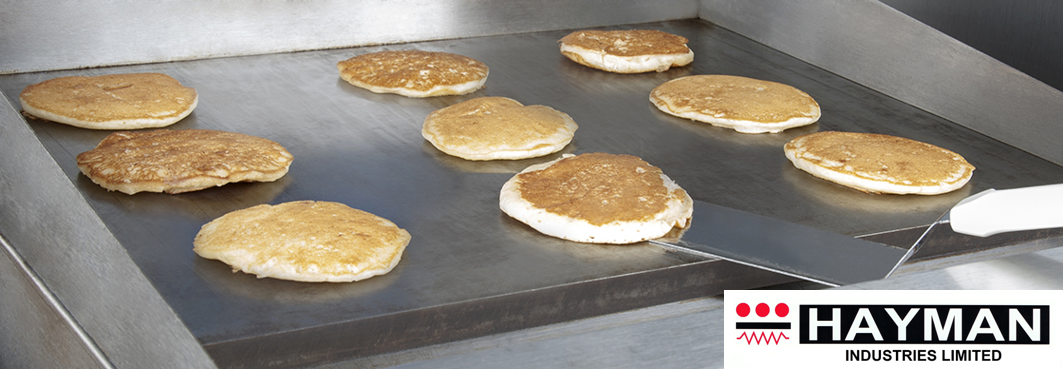|
You’ve finally got enough cash to invest in that new commercial griddle for your kitchen. You can almost smell the wondrous aromas that fill your commercial kitchen. The scent of meats, sauces, and spices fill the air. The clinking and clanking of cookware, dishes, and utensils sound like a symphony to your ears. You place your hand on your new griddle’s control knob. But will you choose an electric or a gas griddle? Commercial Griddles Buyers' Guide
Burgers, pancakes, eggs, and grilled cheese sandwiches are just a few customer favorites that no equipment can prepare better than a commercial griddle/grill. These flat-top workhorses are available with a number of different features that determine how they can be used and the volume of food they can be used to prepare. If you're in the market for a new one, consider these important griddle features as you shop to ensure you pick the right one for your kitchen. Griddle Plate Thickness The thickness of a flat-top griddle's plate determines several of the equipment's important qualities. First, a thicker plate is more durable, which means it can withstand the stress of repeatedly heating up and cooling down without warping or showing signs of wear and tear. Second, a thicker griddle plate heats more evenly and stays hotter after batches of cold food are added. That creates a surface that can cook more food over a given period of time than a thinner plate. Griddle Plate Finish Most commercial griddle plates are made of a steel alloy or stainless steel, with some given top layers of chrome to give the plate some special properties. Chrome is non- porous, so it's less likely to transfer flavor between different types of food. It also helps keep food from sticking and eliminates the need to season the cooking surface with oil. Finally, chrome is a non-reactive metal, so it won't impart a metallic taste to acidic foods or turn light-colored foods dark. Griddle Depth & Width Measured from the front of the griddle plate to the back, griddle plate depths range from 350 to 600 mm. Griddle width is the side-to-side measurement of the equipment. Flat-top griddles are commonly sized in width increments of 300 mm and range from 300 to 900 mm wide. Both of those measurements will determine how much product you can cook in a single batch and how much space the equipment will take up in the kitchen. Before you decide on a griddle, make sure it will fit in the space you have available. Be sure to take into account the clearance requirements, which is the space needed between the griddle and surrounding walls and equipment. Griddle Controls Economy griddles are made with manual controls, a type that gives users control over the intensity of each burner from low to high. Experienced cooks will likely have learned what setting to use for each menu item they prepare, but novice and more exacting chefs prefer to control the precise temperature of their griddle's cooking surfaces. For that, choose a commercial griddle with thermostatic controls. This type of control lets users dial in the temperatures they want to cook with, usually between 60 and 280 degrees Celcius. There are three main types of thermostatic griddle controls. Types of Thermostatic Controls
Griddle Burner BTUs The amount of heat that a griddle generates is measured in BTUs. A burner that generates a higher number of BTUs can keep a griddle hotter and provide better recover rates from batch to batch, so higher BTUs translate to quicker cooking. Economy griddles may include burners that produce as little as 20,000 BTUs an hour, while more powerful medium- and heavy-duty gas griddles will produce 30,000 BTUs per burner or more. Electric Griddles So far our discussion has covered mainly gas griddles, but there are several reasons that operators ultimately choose electric griddles. Benefits of Electric Griddles
Commercial electric griddles are available with three voltage options. Low-volume griddles operate on 120 volts, which will provide enough power for cooking small volumes of food. Since these less-powerful griddles are powered by standard 120-volt outlets that are available in commercial and non-commercial venues, 120-volt griddles are often built to be portable, making them a good solution for caterers and travelling chefs. If your electric griddle will be one of your primary pieces of equipment, you'll likely want to invest in a more powerful 240-volt unit. If your kitchen is serviced by 3-phase power, a 208-volt griddle may be an option. These more powerful commercial griddles are often capable of producing enough heat to keep up with gas-powered equipment. Whereas the heat output of a gas griddle is measured in BTUs, commercial electric griddle power is measured in watts. Higher wattage means the equipment can keep a hotter plate. The standard is 4,000 to 6,000 watts per heating element. The amount of heat generated by elements in that range is roughly equivalent to 15,000 to 20,000 BTUs. Hayman Industries has a great range of Grills to fir your requirements. To find out more about Hayman Grills contact us here.
0 Comments
Your comment will be posted after it is approved.
Leave a Reply. |
Archives
November 2020
Categories |
Contact Us
|
© Hayman Industries Ltd 2018
|


 RSS Feed
RSS Feed
